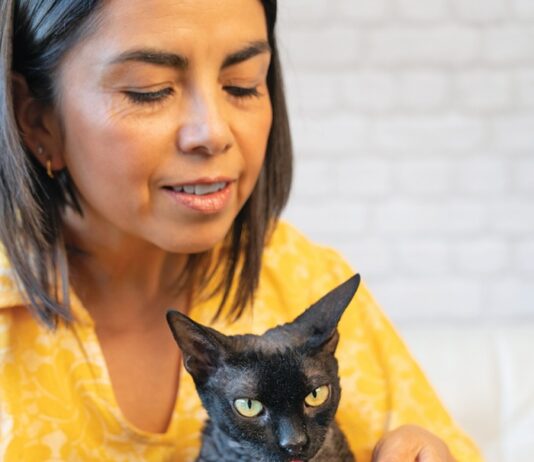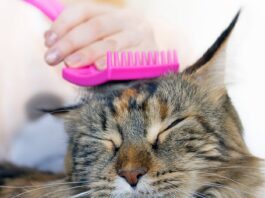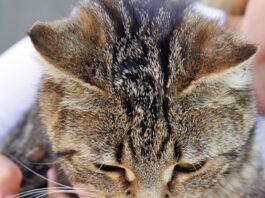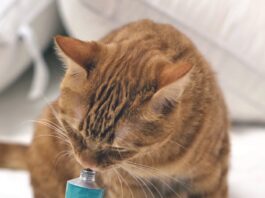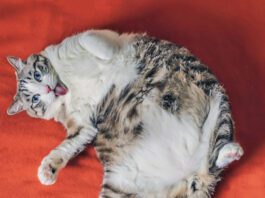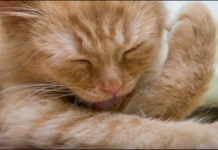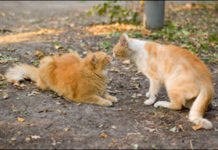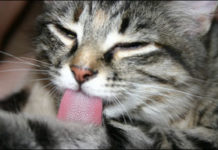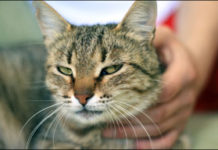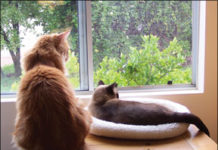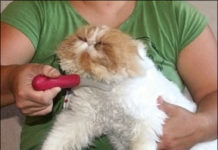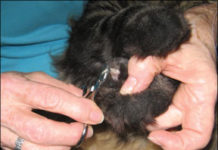Your Cats Fur as a Health Barometer
One of your favorite things about your cat is her sleek, shining fur. Lately, though, it seems like your cat has been having a bad fur day — maybe even several. Her fur looks rather unkempt. When you think about it, she hasn’t seemed very interested in grooming herself over the past couple of weeks. What’s going on? A decline in grooming, or a change in your cat’s fur, are some of the subtle signs that may indicate your cat is ill. In fact, you can view your cat’s fur as a barometer of her overall health and well-being. If you do notice a change, report it to your veterinarian so that you can take steps to start any necessary treatment quickly.
Your Cat’s Fur as a Health Barometer
One of your favorite things about your cat is her sleek, shining fur. Lately, though, it seems like your cat has been having a bad fur day — maybe even several. Her fur looks rather unkempt. When you think about it, she hasn’t seemed very interested in grooming herself over the past couple of weeks. What’s going on? A decline in grooming, or a change in your cat’s fur, are some of the subtle signs that may indicate your cat is ill. In fact, you can view your cat’s fur as a barometer of her overall health and well-being. If you do notice a change, report it to your veterinarian so that you can take steps to start any necessary treatment quickly.
The Importance of Claw Care
The typical cat will spend up to 18 hours a day sleeping and as much as 50 percent of its waking hours meticulously grooming itself. In addition to persistently licking its coat in order to keep it clean and free of dirt and parasites, the animal will pay special attention to its claws, which serve it well as invaluable tools and, when the need arises, as formidable weapons. "A cat in the wild uses its claws for a wide variety of purposes," says William Miller, VMD, medical director at Cornell Universitys College of Veterinary Medicine.
Ask Elizabeth: June 2011
I have had whiskers all my life, but I really took them for granted until recently. Whiskers just seemed like big, fat hairs to me! So what are they, exactly? Well, all of a cats fur grows from hair follicles in the epidermal layer of the skin. Whiskers are specially modified (big, fat) hairs that grow from very large follicles in specific locations. Of course, the most prominent whiskers are those that grow on the upper lips of the muzzle.
The Danger of Hairballs
Every so often, your otherwise fastidious cat will do an alarming and somewhat disgusting thing. Shell awake from a peaceful nap, rise up on her paws, retch convulsively for a moment or two, and spit up what may appear at first glance to be a damp clump. What the animal has disgorged - in the middle of your kitchen floor or, worse yet, in the middle of your prized Persian rug - is a trichobezoar, a wad of undigested hair that is commonly referred to as a hairball. Despite the term, disgorged hairballs are not usually round. They are often slender and cylindrical, shaped more like a cigar or sausage than a ball. According to Richard Goldstein, DVM, an associate professor of small animal medicine at Cornell Universitys College of Veterinary Medicine, a spit-up hairballs elongated shape is imparted by the narrow food tube (esophagus) in which it develops or through which it passes on its journey from the cats stomach to the outside world. However, he notes, a hairball that is not disgorged and remains in the stomach will indeed be round - "like a sponge or a rolled-up sock," he says.
Abscesses: Take Them Seriously
For several days, your cat has been acting uncharacteristically lethargic and off his food. Then one evening, while stroking his back, you feel a smallish lump just to the side of his tail. Although you touch the lump gently, he responds with a hiss, leaping from your lap and scurrying into a dark corner. The lump you discovered is quite possibly an abscess, and the sensitive swelling may indicate that the cat has an infection - and necessitating prompt veterinary care. Distinctive Characteristics. An abscess is a localized collection of pus, a yellowish fluid that forms at the site of an infection. Although pus typically contains a certain amount of cellular debris and dead tissue, it is composed mainly of white blood cells that have been summoned by the immune system to combat invading bacteria or other microorganisms. Cats can develop a variety of lumps and bumps on their skin - cysts, tumors, pimples and so forth - but abscesses have their own distinctive characteristics, notes William Miller, VMD, medical director at Cornell Universitys Companion Animal Hospital. "Because an abscess is filled with pus," he says, "it will be inflamed, warm and tender. Tumors are not usually like that, and pimples are merely superficial eruptions, affecting the outer layer of skin and minuscule by comparison to an abscess." External and Internal. An abscess may develop at the site of a penetrating wound - if a cat steps on a thorn, a wood sliver or a piece of glass, for example. But abscess-producing infections in cats usually result from bites from other cats, since the bacteria that cause infection are normal inhabitants of the feline mouth.
Fur Changes Can Spell Trouble
One of your favorite things about your cat is her sleek, shining fur. Lately, though, it seems like your cat has been having a bad fur day - and she hasnt seemed very interested in grooming herself over the past week or so. Whats going on? "A decline in grooming or a change in the cats fur are some of the subtle signs that your cat may be ill," says Jane Brunt, DVM, of the Cat Hospital At Towson in Baltimore, Maryland. In fact, you can view your cats fur as a barometer of her overall health and well-being. If you do notice a change, report it to your veterinarian so that you can take steps to start treatment quickly. Ilness Indicator. One of the most common fur changes in cats is the loss of hair. You might notice clumps of fur coming out when you pet her, or her fur might just start to look patchy and scraggly. Causes for hair loss - called alopecia - include skin parasites (fleas and mites) and internal parasites (tapeworms or roundworms). These culprits indirectly rob your cats body of vital nutrients.
A Ban on Declawing?
The San Francisco Commission of Animal Control and Welfare wants the city to ban the declawing of cats. In a July hearing, the Commission voted 5 to 1 to recommend that the citys Board of Supervisors adopt an ordinance to ban the practice. (It would exclude cases where declawing is necessary for a cats health.) If passed, San Francisco will be the second city in the U.S. with such an ordinance. West Hollywood, CA, banned the practice in 2003.
A Health Checklist to Perform at Home
The owner is the veterinarians eyes and hands away from the office," explains Fred Scott, DVM, PhD, interim director of Cornells Feline Health Center. For this reason, it is important to be familiar with the steps involved in doing an at-home mini-physical examination on your cat. This should supplement your cats twice yearly trips to the veterinarian. Performing an at-home physical examination is much easier than you might think; in fact, Dr. Scott points out, the examination should be a normal extension of the regular attention you give your cat.
Ten Ways to Go Green
It should come as no surprise that Mother Nature is on the verge of taking a permanent sick day. After all, harmful climate changes due to greenhouse gases, air and water pollution, and the destruction of natural habitats are putting our planet and its inhabitants - both two- and four-legged - in peril. Hopefully, many of us have begun to make some changes in our daily lives to help reverse the damage done to, well, everything. But what role can our cats play in being good stewards of our beleaguered planet? There are many practical ways to reduce your felines carbon pawprint, which include switching to a corn or wheat-based cat litter and recycling cat food containers instead of throwing them in the trash. Get a jump start on Earth Day (April 22) by incorporating the following tips into your daily routine. Start out slowly if you wish by trying one or two new tips each week. Encourage your friends, family members and co-workers to join in your quest for a sustainable future. Youll find that its not only fun and easy to "go green," but youll see that you can make a positive and lasting impact on our world, which will please Mother Nature.
Help for the Matted Cat
While it may seem unlikely to you (given the reputation cats have for personal hygiene and grooming habits), a trip to the groomers can sometimes become necessary for a badly matted cat. There are several factors which can contribute to the matting of a cats haircoat, two ways to deal with it - and one simple way to avoid it in the future. Jana West, owner and operator of Shampooch, located in Savona, NY, has been grooming cats and dogs for eight years. West relates that the most common places for a cat to develop mats are on the back - near the tail, under the belly, along the hind legs and under the tail. She explains that there are three types of cats that [IMGCAP(1)]are more prone to developing mats in their haircoat: "The majority of the cats that have a problem are older cats, bigger cats or cats allowed to spend time outdoors." As cats age, grooming may become less important to them. In addition, cats with a weight issue may have more difficulty reaching certain areas of their bodies. And when it comes to outdoor cats, West adds, "Ideally, all cats would be kept inside and wouldnt come in contact with burrs and branches, but thats not always realistic."
Care for Your Cat’s Claws
The typical cat will spend up to 18 hours a day sleeping and as much as 50 percent of its waking hours meticulously grooming itself. In addition to persistently licking its coat in order to keep it clean and free of dirt and parasites, the animal will pay special attention to its claws, which serve it well as invaluable tools and, when the need arises, as formidable weapons. "A cat in the wild uses its claws for a wide variety of purposes," says William Miller, VMD, medical director at Cornell Universitys College of Veterinary Medicine. "It will use them to scratch its skin when it itches, mark its territory, provide traction when it wants to climb a tree trunk, or dig a hole to go after a mouse. A cat will also use its claws to conceal its scent from predators by scratching dirt over a spot where it has urinated or defecated." In the course of their routine activities, most cats - especially those that spend a lot of time outdoors - will be able to maintain their claws at proper length, notes Dr. Miller. Cats that live mainly indoors will usually be able to accomplish this as well if they have access to a sturdy scratching post. In some cases, however, a cats claws can become too long, a situation that can have harmful implications for the animal and possibly its owner.

